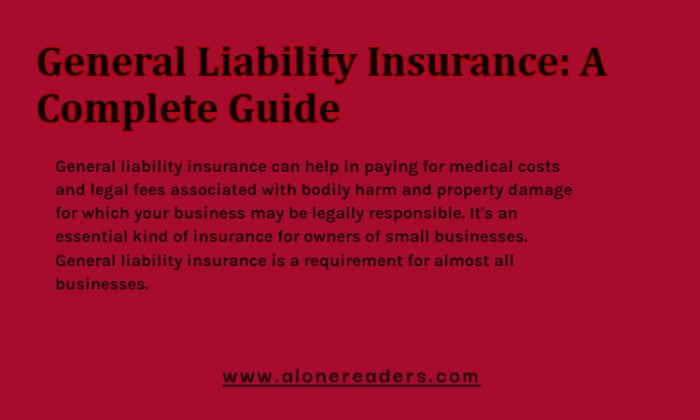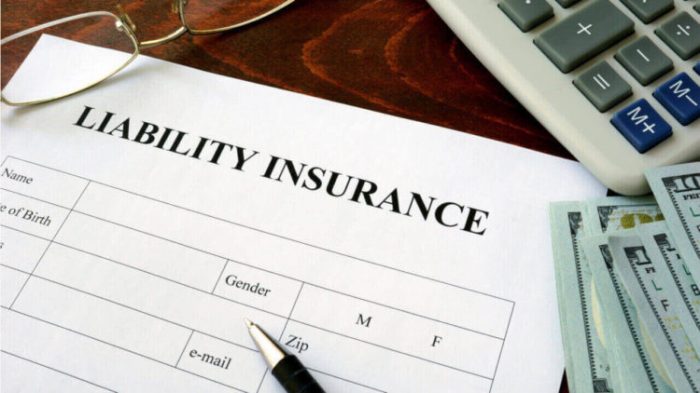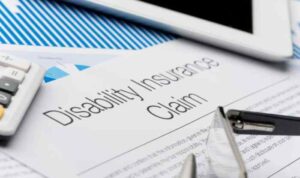Starting with the liability insurance guide, we dive into the world of insurance coverage, breaking down complex concepts into easy-to-understand terms. From understanding policy types to filing claims, this guide has you covered.
Overview of Liability Insurance
Liability insurance is a type of coverage that protects individuals and businesses from the risk of being sued for negligence that results in bodily injury, property damage, or personal injury to others. It is essential as it helps cover legal expenses, medical bills, and damages that may arise from such incidents.
Types of Liabilities Covered
- General Liability: Covers injuries and property damage caused by your business operations.
- Professional Liability: Protects against claims of professional errors or negligence.
- Product Liability: Covers damages caused by products you manufacture or sell.
Scenarios where Liability Insurance is Beneficial
- Accidents at a Business Premises: If a customer slips and falls in your store, liability insurance can help cover their medical expenses.
- Professional Mistakes: If a client sues you for errors in your work, professional liability insurance can cover legal fees.
- Defective Products: If a product you sell causes harm to a consumer, product liability insurance can help cover the resulting damages.
Types of Liability Insurance: Liability Insurance Guide

General liability insurance provides coverage for a business in case of third-party claims for bodily injury, property damage, or advertising injury. This type of insurance is essential for protecting a business from financial loss due to lawsuits or settlements.
Professional Liability Insurance (Errors and Omissions), Liability insurance guide
Professional liability insurance, also known as errors and omissions insurance, is crucial for professionals who provide services or advice to clients. This insurance protects against claims of negligence, errors, or omissions that result in financial harm to clients. It is particularly important for professions such as doctors, lawyers, consultants, and architects.
Product Liability Insurance
Product liability insurance is necessary for businesses that manufacture, distribute, or sell products. This type of insurance provides coverage for claims related to injuries or property damage caused by a faulty product. Product liability insurance helps protect businesses from costly legal expenses and settlements in case of product-related lawsuits.
Choosing the Right Coverage
When it comes to liability insurance, selecting the right coverage is crucial to protect yourself and your assets. Here are some tips to help you determine the appropriate coverage amount and factors to consider when choosing a liability insurance policy.
Tips to Determine Appropriate Coverage Amount
- Assess your assets: Consider the total value of your assets, including property, savings, and investments, to determine how much coverage you may need.
- Evaluate your risks: Identify potential risks associated with your business or personal activities to understand the level of liability coverage required.
- Consult with an insurance agent: Seek professional advice from an insurance agent to assess your specific needs and determine the right coverage amount.
Factors to Consider When Selecting a Liability Insurance Policy
- Coverage limits: Ensure the policy offers adequate coverage limits to protect you in case of a liability claim.
- Exclusions: Review the policy exclusions to understand what is not covered and assess if additional coverage is needed.
- Premium costs: Compare premium costs from different insurance providers to find a policy that fits your budget without compromising on coverage.
Comparing Insurance Providers and Offerings
When comparing insurance providers, consider their reputation, customer service, and the specific liability insurance offerings they provide. Look for a provider that not only offers competitive rates but also has a strong track record of handling claims efficiently and effectively.
Understanding Policy Exclusions

When it comes to liability insurance policies, it’s crucial to understand the exclusions that may apply. These are specific situations or conditions that are not covered by the policy, which can have significant implications for policyholders.
Common Exclusions in Liability Insurance Policies
Policy exclusions can vary depending on the type of liability insurance you have, but some common exclusions include intentional acts, contractual liabilities, and professional services. Intentional acts refer to any harm or damage caused on purpose, which is not covered by liability insurance. Contractual liabilities are responsibilities agreed upon in a contract that are not covered by the policy. Professional services exclusions apply to any errors or omissions related to professional advice or services.
Implications for Policyholders
- Policy exclusions can leave policyholders vulnerable to financial losses if a claim falls under an excluded category.
- Understanding these exclusions is essential to assess the level of risk and determine if additional coverage is needed.
- Policyholders need to carefully review their policy documents to be aware of any exclusions and make informed decisions.
Examples of Situations Where Policy Exclusions May Apply
For example, if a business owner intentionally damages a client’s property, this intentional act would not be covered by liability insurance. Similarly, if a contractor fails to fulfill a contractual obligation, any resulting liabilities may not be covered under the policy.
Filing a Liability Insurance Claim
When it comes to filing a liability insurance claim, there are certain steps you need to follow to ensure a smooth and successful process. Understanding these steps, common reasons for claim denials, and how to avoid them can help you navigate the claims process effectively. Here are some tips to guide you through filing a liability insurance claim:
Steps Involved in Filing a Liability Insurance Claim
- Notify your insurance company: As soon as an incident occurs that may lead to a liability claim, it is crucial to inform your insurance provider to start the claims process.
- Gather necessary information: Collect all relevant details about the incident, including photos, witness statements, and any other evidence that can support your claim.
- Fill out claim forms: Your insurance company will provide you with the necessary forms to fill out. Make sure to complete them accurately and provide all requested information.
- Cooperate with the investigation: Your insurance company may conduct an investigation to assess the validity of your claim. Cooperating with this process can help expedite the claims resolution.
- Review the settlement offer: Once your claim is processed, review the settlement offer carefully to ensure it covers all your losses adequately.
Common Reasons for Claim Denials and How to Avoid Them
- Failure to report the claim on time: Notify your insurance company promptly after an incident to avoid claim denial due to delayed reporting.
- Policy exclusions: Understand your policy exclusions to avoid filing claims for situations not covered by your liability insurance.
- Insufficient evidence: Provide all necessary evidence to support your claim and increase the chances of a successful resolution.
- Misrepresentation: Be honest and accurate when providing information to your insurance company to avoid claim denial for misrepresentation.
Tips for a Smooth and Successful Claims Process
- Keep detailed records: Maintain thorough documentation of the incident and all communication with your insurance company throughout the claims process.
- Follow up regularly: Stay in touch with your insurance adjuster to track the progress of your claim and address any concerns promptly.
- Seek professional help if needed: If you encounter difficulties during the claims process, consider consulting with a legal or insurance professional for guidance.
- Stay patient and persistent: Resolving a liability insurance claim can take time, so remain patient and persistent in pursuing a fair settlement.

